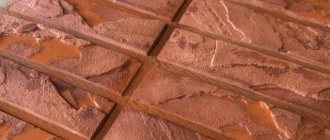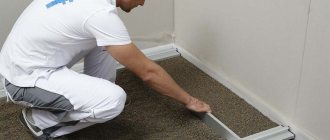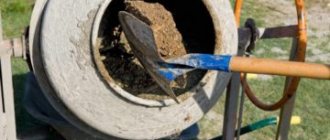To transform your own plot of land, it is recommended to have information on how to properly paint a concrete path. Concrete is considered one of the simplest and most common materials for cladding outdoor structures. To give the gloomy grayish stone an interesting appearance, uniqueness and brightness, craftsmen use a variety of materials. This is an easy and relatively cheap method to decorate the garden area and around the house.
Staining Concrete - Basics
Concrete will be required for construction and production of building materials. The material itself has a number of properties. Qualities:
- strength;
- resistance to mechanical damage;
- an easy way to create elements;
- durability.
When choosing what to paint concrete with, you will need to take into account all the requirements of the material for the coating. An example would be outdoor concrete paint. It must combine durability, attractiveness, as well as resistance to moisture and solar radiation.
Important! There are differences between painting concrete outdoors and indoors that will need to be taken into account when choosing a technology. This is due to the requirement to protect building materials used outdoors, since they are exposed to sunlight, precipitation, and changes in ambient temperature.
Why do this?
Painting concrete is considered a necessary activity. This procedure is carried out for reasons of aesthetics, as well as to protect the surface from negative influences. Reasons for painting a concrete surface:
- dust removal;
- obtaining protection from mechanical damage or wear;
- resistance to chemicals, temperature changes and similar factors;
- extension of service life;
- good view;
- improved performance.
Painted concrete surface will have a set of qualities depending on the type of product. Select materials that meet the necessary criteria. An example is the choice of varnish for the garage floor. It must have a good level of resistance to aggressive substances. The path in the country house or the porch of the house should be treated with varnish that is resistant to water.
The coating improves the interior and protects building materials from damage.
Path design techniques
The finished tiles are made from a cement-sand or gravel mixture by casting or vibration pressing. The second option is the most durable, suitable for vehicle passages and parking lots. For garden paths, it is better to choose a less heavy design option.
Durable and reliable monolithic concrete path from the gate to the house
A beautiful red concrete path at the back of the garden plot
“Portable” path in the garden area of a suburban area
Now about the texture of the finished tiles:
- concrete paving stones look like bricks and are often used for border framing;
- figured or mosaic details of various colors are well suited for creating ornaments;
- textured with an anti-slip effect, practical, but not too decorative;
- concrete products with a surface decorated with a pattern, reminiscent of stove tiles, are used to decorate recreation and relaxation areas;
- imitating natural stone, containing plasticizers, they have a smooth surface and a luxurious appearance.
The monolithic tape maintains its integrity on sandy soil, where frost heaving is excluded. When there is a lot of clay in the ground, a monolithic path will require a solid foundation up to 20 cm thick.
When pouring a monolith, a reinforcing mesh is used to hold the concrete during seasonal soil movement.
A walkway with reinforcement will last much longer
It is convenient to make tiles yourself. The concrete solution is prepared on site. The following are used as fillers:
- fine sand or gravel;
- crushed plastic bottles or rubber car tires;
- vegetable components: husks, chopped straw, sawdust or shavings.
Self-casting of tiles is carried out on a level area using a building level. The proportions of water, cement and filler are determined depending on the brand of cement used and the potential load.
Painting inside and outside, what's the difference?
How to properly paint concrete depends on the requirements for the surface of the material, as well as the location of the work. The difference in painting manifests itself in several conditions:
- What and how to paint concrete. When finishing inside, the layer's resistance to environmental influences will not be required. When painting outdoors, you will need to take into account all the negative factors to which the surface will be exposed.
- Procedure time. Inside, work can be done at any time. Outdoors, the process is only possible in good weather without precipitation.
- Temperature conditions. Concrete in outdoor conditions is painted only at temperatures above 5 degrees.
Take into account that incorrect painting of concrete walls on the outside will lead to deterioration in the quality of the coating.
Important! When working outside, a work plan is drawn up in advance, which eliminates all factors affecting the durability of the coating.
Instructions for painting walls yourself
Painting the surface begins from the top point, dividing the wall with tape into separate sections. Operations are performed in cloudy, dry conditions or on the shady side of the building. The concrete is lightly moistened by spraying before painting.
Paint the surface evenly without leaving gaps. The next layer of paint is applied after the previous one has dried.
A day after the multilayer coating has dried, sealant is applied to the surface with a roller in one direction. When dry, the product becomes invisible.
Which product to choose, types of materials
Not all paints and products are suitable for concrete. It is important to remember that for each procedure a different version of varnish is selected. All types of paint have their own set of qualities and characteristics.
Oil paints
Oil-based paints are used for painting interior and exterior surfaces. The downside is toxicity due to the special composition with solvents. Paint is rarely used in poorly ventilated areas. It is optimal to use it for outdoor work. An example would be painting a concrete fence. Pros:
- low price;
- moisture resistance and resistance to atmospheric factors;
- beautiful coating with a durable base;
- easy cleaning;
- long-term operation;
- good level of adhesion;
- many colors.
Among the disadvantages are a strong odor, long drying time, and a low level of elasticity, which often contributes to the appearance of cracks.
Water based paints
Water-based painting materials have a set of positive aspects that allow craftsmen to use paint for any work. This point also applies to painting indoor walls. Pros:
- environmental friendliness;
- no fear of moisture;
- quick drying;
- no odors;
- easy to use;
- any colors.
The only downside is the price, which is higher than the oil version. The coating does not contain harmful substances, therefore it is recognized as a good method for interior decoration of residential buildings. For exterior work, façade paints are used. Paint characteristics and operating conditions are indicated on the packaging. For outdoor work, wear-resistant varnishes are selected.
Acrylic paint
Acrylic paint is considered a universal product that is used for exterior and interior work. When choosing, pay attention to the purpose of the paint. It may have the characteristics necessary for painting facades, walls, ceilings, as well as for artistic purposes.
Pros:
- the coating is environmentally friendly and safe;
- resistance to mechanical stress;
- elasticity;
- vapor permeability, which allows the coating to breathe without condensation;
- the color does not fade with prolonged use;
- tinting possible;
- moisture resistance and resistance to any type of wear;
- extended service life.
Alkyd compositions differ from similar options not only in their set of advantages, but also in their high cost.
Silicate based paints
Silicate paint is considered a durable material. The basis of the coating is liquid glass, which covers the surface with a film of high strength.
Important! The consumption of each silicate option differs, so when choosing, you will need to read the instructions, which indicate the required numbers.
Pros:
- is not damaged by chemicals and is resistant to their effects;
- stable color range;
- durability due to increased strength;
- moisture resistance and fire safety;
- not susceptible to fungi and mold.
The wear-resistant coating option is used for any surface, but you need to remember that the composition contains a number of toxic substances.
If it is necessary to create an elastic coating, use paints with a rubber base, which makes the texture soft. This eliminates chips, cracks and similar damage.
Impregnations for concrete
The painting process requires a preparatory procedure. To level the layer on the floor or wall, a special impregnation is used. It is made on the basis of acrylics, polyurethane or epoxy resins.
Impregnations differ in their set of characteristics. Examples include transparent options, as well as antiseptics. Pre-impregnation helps reduce paint product consumption and apply an even layer. Concrete will not become dusty or crumble during work, which will affect aesthetics and durability.
Marking passages on the site - how to do it beautifully
Before designing, you should determine what types of paths and how many of them should be on the site. Utility rooms are intended for access to objects located around the house: a barn, a woodshed, a bathhouse. Walking chairs are for utilitarian purposes and are needed as decorative elements.
When planning a site, it is necessary to calculate the required number of paths
The most durable and long-lasting paths should be those that are used most often. First of all, this is a path from the gate to the house
Paths and paths add a picturesque touch and serve to visually adjust the territory. Short sections divide the garden into small fragments, making the area appear smaller. Winding paths, on the contrary, will create the impression of spaciousness.
Two to three operational passes are enough, the rest have a decorative function.
Any garden path should be practical, without puddles or potholes. When designing a garden, areas of high humidity are noted in the garden drawing. It is important to make the correct slope so that rain and melt water drains away faster, and to provide drainage in an area with high groundwater levels.
When there are too many paths, they divide the area into small fragments, making it look much smaller than it actually is.
A long path visually enlarges the area
Paths between flower beds and beds are made from separate unconnected fragments so that coverings can be easily dismantled and damaged tiles replaced with new ones.
A path made of individual tiles can be easily moved to another place if necessary
Durable coatings are necessary for heavy loads, in places where people constantly move. On small paths it is wise to lay coatings of a small thickness.
Winding paths with hedges create intrigue, creating the illusion of a long journey and space.
Tools, painting equipment, protective equipment
Working with a concrete surface requires a set of tools that differs from analogues for working with stone and tiles. This is due to the need to pre-finish and prepare the concrete for the painting process. Set of tools and tools:
- brushes and rollers, spray gun;
- protective film;
- spatulas and spatulas for applying putty primer;
- protective equipment in the form of a mask and gloves.
When adding pigment, before starting work, you will need to have a mixer, as well as containers for pouring the blind area.
The list of funds depends on the technology of work. For regular painting of an already finished surface, it is enough to have brushes and materials that are selected based on the requirements.
Technology
Painting an object involves performing mandatory and additional actions. The first is preparation of the base and finishing. The second includes dismantling, removing debris, working to protect adjacent structures from dust and contamination, limiting the work area with waterproof materials (adhesive tapes, tapes, films, stencils). Let's look at how to properly paint a concrete wall, floor, ceiling or exterior structure.
Preparing the base
Before painting concrete, it must be properly prepared. The base must be dry, clean, free of grease stains and free from rust or fungal growths. Since paintwork materials create a thin film, they are practically unable to fill pores and cracks. That is, you additionally need to remove dust from the surface and fill in all defects.
Upon closer examination, the following materials and means are used to solve the assigned problems (examples):
- cleaning of old paint - compositions with a high alkali content;
Mechanical removal of old coating Source yandex.net
- degreasing – 500 grams of soda ash with the addition of 10 liters of water;
- rust removal - removal with water and prevention with a solution of copper sulfate (15%);
- elimination of mold - impregnation with a destroyer followed by mechanical removal, washing with clean water, preventive treatment with a protective antiseptic for concrete (mineral surface);
- dust removal (before each stage of concrete preparation) - deep penetration primer, applied in at least 2 layers with intermediate drying.
To fill pores and cracks, plaster and putty are used, which are intended for working with mineral bases. If the surface is uniform and without defects, then you can immediately begin sanding. This will ensure smoothing, which will have a positive effect on the aesthetics of the paint coating. The grain size of the abrasive cloth can be equal to 80-100 units.
Sheets of sandpaper Source cloudinary.com
Coloring
Work is performed only on monoliths more than 30 days old after pouring. An exception is the use of dry pigment to tint a freshly poured walkway. Optimal conditions are considered to be temperatures above +10 degrees Celsius and relative air humidity in the range of 60-75%.
Concrete has low absorbency. Therefore, the application of the coloring composition must be impregnating in nature. The best way to solve the problem is with a roller. For the spray gun you need to use watery compounds. Spray the paint in 2-3 passes in a thin layer with intermediate drying within 12 hours.
Painting with a brush is also acceptable. Here you need to be prepared for the appearance of furrows from stubble. This is justified by the use of viscous paints. To visually smooth out the coating, you can paint the surface in 2-3 layers.
Acrylic paints
Acrylic paint has very good adhesion to the base, elasticity, resistance to dirt and water washing. It boasts low permeability, is suitable for restoring an old façade, it can also be used to paint mineral substrates, and to lay it on previously painted layers of cement and cement-lime plaster. It should not be used on silicate or lime plastered surfaces.
Acrylic paint consumption - 110-135 g/m².
Acrylic facade paints
Paints based on acrylate and vinyl, as well as those based on silicone resins, can be either water-soluble or solvent-soluble
Polysilicate and silicate paints
Silicate paints are quite resistant to moisture compared to lime paints, but have almost identical good vapor permeability. They are highly durable, resistant to mold and the harmful effects of atmospheric factors. Silicate paints are very resistant to contamination; the coating does not electrify. There is a fairly limited range of colors available for sale.
Silicate paints repel water
Polysilicate paints are a modern innovative type of silicate paints, formed by enriching them with various resins. Such paints are much easier to apply. They have excellent water resistance, high vapor permeability and, unlike their predecessors, are compatible with organic plaster.
Building facade painted with silicate paints
Consumption of polysilicate paint is 140-150 g/m².
Silicate facade paint Ceresit CT 54
Photo of beautifully executed concrete paths in the country
Original examples of concrete paths are presented in the photo selection. Using designer tiles, they create gardens in fashionable English and French styles. The simplest option for arranging a path with a fantasy approach will turn into a bright design accent. A combination of concrete with other types of coatings will help give a narrow alley a modern look. Experiments, flights of fancy, and individuality are in trend.
Classic style garden with concrete slab paths
The Mediterranean style will be complemented by a concrete path if you add pebbles, shell fragments, broken glass, which will sparkle in the sun.
To create a beautiful mosaic decor, you will have to be patient.
Original forms are welcome. Using soft formwork, they create paths with wavy edges, teeth, and asymmetry. This composition is much more elegant than classic paving stones.
The tiles in soft formwork are poured directly on the spot, after the solution has set, the mold is moved and the pouring is repeated again
To make tiles, old kitchen utensils and ready-made stencils are used as a mold. The resulting coatings are not inferior in strength to store-bought counterparts.











